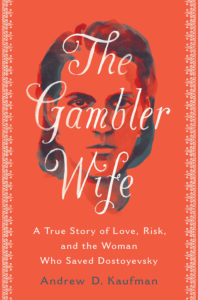5 Dostoyevsky Works You Want To Learn More About
In my latest book, The Gambler Wife: A True Story of Love, Risk, and the Woman Who Saved Dostoyevsky, I tell the story of Dostoyevsky’s second wife, Anna, who was indispensable in helping the great author overcome a long list of personal, business, and literary struggles. It was with her help that he was able to create some of the most important works of world literature.
Crime and Punishment and The Brothers Karamazov are his best-known novels, and Notes from the Underground, The Idiot, and The Possessed are all widely read and taught. But those are just the highlights of his prodigious catalog. Reading some of his lesser-known novels, short stories, and novellas is an excellent way to learn more about the author and examine ideas that recur again and again in his later creations.
Here are five of his works that, while not as widely read today, still are worth examination.
Netochka Nezvanova (1849)
Dostoyevsky was in the midst of publishing this novel serially when he was arrested in April 1849. Along with several other notable progressive literary figures of the era, he was exiled to a Siberian detention camp for his anti-Tsarist views. Before his arrest, he had published the first two installments of Netochka Nezvanova, and the third appeared a month later. While in exile, he survived a mock execution and four years of hard labor.
When he finally made it home, however, he never returned to the book. If he had, it would have become nineteenth-century Russia’s first feminist novel: the very first book, as scholar Joseph Frank noted, to “depict a talented and strong-willed woman who refuses to allow herself to be crushed—who becomes the main positive heroine of a major [Russian] novel.”
In researching my new book, The Gambler Wife: A True Story of Love, Risk, and the Woman Who Saved Dostoyevsky, I learned that the story had a profound influence on Dostoyevsky’s second wife, Anna, when she read it as a 16-year-old. Her family even nicknamed her “Netochka Nezvanova” because of her fondness for Dostoyevsky. As luck would have it, she would meet the famous novelist four years later when he needed a stenographer, changing the course of both their lives.
The story recounts the anguished childhood of Netochka Nezvanova (translated as “Nameless Nobody”), a talented, emotionally abused orphan girl who is shepherded from one “accidental family” and dysfunctional relationship to the next. At the age of eighteen, she is able to channel her painful experiences into a budding singing career. In fashioning such a story, Dostoyevsky was anticipating one of the most dramatic upheavals in Russian culture of the mid-nineteenth century: the rise of a distinct feminist movement.
While the story is unfinished, the 176-page novella is filled with memorable characters and highlights many common themes for Dostoyevsky.
The Insulted and Injured (1861)
This was Dostoyevsky’s first major work since returning from Siberia. The Insulted and Injured (1861) is a sentimental melodrama filled with colorful characters and dramatic cliffhangers at the end of each chapter — elements that made him enormously popular among readers, if distasteful to critics. Its success enabled him to re-enter the publishing world after his long absence.
The novel tells the tale of the dreamy, penniless young writer Ivan Petrovich, whose love for Natasha is scuttled after her parents force him to postpone their marriage until he is more established professionally. Natasha falls in love with Alyosha, the ne’er-do-well son of a cruel, wealthy merchant, until he tries to steer Alyosha away from Natasha into a more lucrative match.
It was a typical early Dostoevskian plot, with a meek, pure-hearted dreamer-artist confronting a harsh reality peopled with social predators. Oscar Wilde said the novel was “not at all inferior to the other great masterpieces,” and Friedrich Nietzsche purportedly wept over it. Any avid reader of Dostoyevsky will pick up that the lead character, Ivan Petrovich, was a surrogate for the author himself.
The 250-page novel is a departure from Dostoyevsky’s more famous later works, but it’s still an entertaining glimpse into this period of his life and contains many of the social and philosophical themes that would define those masterpieces.
Notes from the House of the Dead (1861)
Dostoyevsky returned to critical favor with his next major work, Notes from the House of The Dead (1860-63), a semi-fictionalized account of the writer’s experiences in a Siberian labor camp. A blend of memoir, social exposé, and cultural criticism, The House of the Dead examines several of his familiar themes, such as the plight of the downtrodden man, the cruelty of officialdom, and the supreme value of Christian compassion.
But it also explored new ideas that would become central to Dostoyevsky’s art and thought in the years to come: the personality’s need for inner freedom at any cost, the psychological complexity of the criminal mind—a topic the writer would return to in Crime and Punishment—and the spiritual depth of the Russian people.
The Gambler (1867)
The story behind the publication of The Gambler is no less fascinating than the novel itself. While in desperate need of money, Dostoyevsky sold the rights to all of his previous work to a shady literary publisher. Part of the deal included a new novel, which was due on the first of November 1866. If Dostoyevsky didn’t deliver it, the novelist would forfeit the rights to everything he wrote for the next nine years. He was so focused on writing Crime & Punishment (which was being published serially at this time) that he ignored the approaching deadline.
By the beginning of October, just a month before this new novel was due, Dostoyevsky had only a few scattered notes and rough plans to show for it. In desperation, he turned to one of his oldest friends, who suggested he hire a stenographer to keep him on track. A Petersburg professor recommended his star pupil, and that’s how the writer met Anna Snitkina, who was instrumental in meeting the deadline. She would go on to become his trusted first reader, editor, business partner, and wife.
As for the novel itself, it borrows heavily from Dostoyevsky’s manic gambling sprees in Europe, along with his ongoing secret affair with a woman named Polina Suslova.
The Gambler is told as a confession by a young man named Alexei Ivanovich, who works as a tutor in the home of General Zagoryansky, now living abroad. By the time the novel opens, Alexei has left his position with the general to become an inveterate gambler, living hand to mouth among the roulette tables of Europe’s most famous spas. Only this Alexei—his name containing in Russian overtones of both nobility and naiveté—is no ordinary gambler.
Whereas the novel’s many polished but passionless European characters come to the casino out of base self-interest, calculating material desire, Alexei is motivated by deeper psychic needs: above all, the need to prove himself, at any cost; to prove that he is a man, not a machine.
The novel’s second major storyline involves Alexei’s tempestuous affair with the general’s stepdaughter, an alluring femme fatale named Polina who toys cruelly with his heart. Alexei falls prey to Polina’s exhilarating game of cat and mouse: In his mind, Polina is capable of raising him to the heavens or crushing him, much as the roulette wheel spins, only to deliver, in one irrevocable second, its terrifying verdict: Is he to leave anointed as a king or a pauper?
The Gambler stands as an acute psychological portrait of Dostoyevsky himself as a man, a gambler, and an artist. That he was able to pay off his gambling debts by writing a novel about a gambling addict is another one of the story’s pleasures.
The Adolescent (1875)
The Adolescent is built upon the idea that disorder is everywhere in society, such that he even considered Disorder as the original title. Dostoyevsky explores this premise through the charismatic and mysterious character of Versilov, the landowner father whose illegitimate son, Arkady Dolgoruky, is the adolescent of the title.
The novel opens with Arkady, having completed his schooling, has come to Petersburg in search of a position and in pursuit of his so-called “idea”: his ambition to become as wealthy as the real-life financier James Mayer de Rothschild, a grandiose goal clearly intended to compensate for deep insecurity over his illegitimacy and poverty. While in Petersburg, he forms a close and complicated relationship with his father, Versilov, whom he hardly knows yet has idealized in his imagination, as well as his mother, Sofya, a virtual stranger to him.
The story combines elements of both the picaresque and the Bildungsroman: Arkady sets out on a tour of discovery and bitter disillusionment through a broad slice of contemporary Russian life, giving the author an opportunity to comment on the full range of a society in moral disarray.
***
Connect with Dr. Kaufman on Amazon, Twitter, Facebook, his private FB Group, Linked In, Instagram, Goodreads, and YouTube, and sign up for his newsletter here.
Follow Books Behind Bars on Twitter and Facebook.
Order The Gambler Wife: A True Story of Love, Risk, and the Woman Who Saved Dostoyevsky
Mailing List
To receive monthly articles, inspiration, and updates, including updates about Andy's new book, The Gambler Wife: A True Story of Love, Risk, and the Woman Who Saved Dostoyevsky, please fill out the form below.

